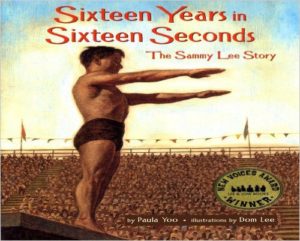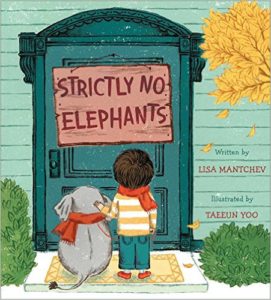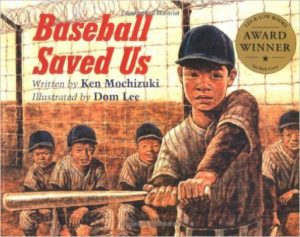Baseball Saved Us by Ken Mochizuki and illustrated by Dom Lee is especially relevant in today’s climate of intolerance and anti-immigration. Baseball is considered by many to be our national past time. In 1942, the United States gathered Japanese Americans, stripped them of their property, forcibly relocated them, and temporarily housed them in horse stalls! Ultimately these families were interned in isolated desert camps.
With little to do, few resources and the constant surveillance of armed guards, tensions grew between the authorities as well as among the internees themselves. It is ironic that these citizens turned to baseball as a way to cope.
Baseball Saved Us serves as both a cautionary tale of how unbridled hate and suspicion can destroy lives and lead countries astray. It is also a brilliant story about how to confront and survive bullying. Four Stars!
 AQ* Lens Chock full of potential leads to conversations about overcoming difficult circumstances and/or ethnic differences as well as bullying, this story can be read many times. Each visit can explore these talking point from a fresh vantage point. The story describes how the young people rejected their elders, turned to disrespect and anger as a response to their difficult circumstances. Since many adoptees also follow this strategy, the story provides a chance to scrutinize this choice from a less personally direct angle.
AQ* Lens Chock full of potential leads to conversations about overcoming difficult circumstances and/or ethnic differences as well as bullying, this story can be read many times. Each visit can explore these talking point from a fresh vantage point. The story describes how the young people rejected their elders, turned to disrespect and anger as a response to their difficult circumstances. Since many adoptees also follow this strategy, the story provides a chance to scrutinize this choice from a less personally direct angle.
 For families with teens, Weedflower by Newbery medal-winning author Cynthia Kadohata is also an excellent book on the unjust internment of Japanese-Americans. The characters are well drawn. By narrating the story through a child’s eyes, young readers can identify more easily with her plight and with the injustice that created this shameful part of American history.
For families with teens, Weedflower by Newbery medal-winning author Cynthia Kadohata is also an excellent book on the unjust internment of Japanese-Americans. The characters are well drawn. By narrating the story through a child’s eyes, young readers can identify more easily with her plight and with the injustice that created this shameful part of American history.
In addition to the challenge of coping with internment, the teens face the universal issues of adolescence: peer intolerance, family dynamics, young love, and interracial relationships. (The camp at which this story is set is adjacent to a Native American reservation. They too, face challenging circumstances because of their confinement to the inhospitable location.) This plot point explores intolerance and prejudice from an additional angle.
Four Stars!
 AQ* Lens This book targets an older audience and offers a chance to explore the same themes mentioned above from a greater depth, e.g, interracial dating. This is an experience that many adoptive families will face. A story like this one allows discussions to occur long before it becomes a reality within a family. Such conversations can help both young reader and parent to explore their thoughts and feelings and perhaps unmask information that might otherwise remain unexplored and unexamined.
AQ* Lens This book targets an older audience and offers a chance to explore the same themes mentioned above from a greater depth, e.g, interracial dating. This is an experience that many adoptive families will face. A story like this one allows discussions to occur long before it becomes a reality within a family. Such conversations can help both young reader and parent to explore their thoughts and feelings and perhaps unmask information that might otherwise remain unexplored and unexamined.
 In Sixteen Years in Sixteen Seconds by Paula Yoo and illustrated by Dom Lee sport again features as the tool that both highlights and ultimately triumphs over prejudice and bigotry. Students may be familiar with the history of banning African-Americans from parks, restaurants, hotels, schools, community pools, etc. Students may not realize that people of other races also faced similar discrimination.
In Sixteen Years in Sixteen Seconds by Paula Yoo and illustrated by Dom Lee sport again features as the tool that both highlights and ultimately triumphs over prejudice and bigotry. Students may be familiar with the history of banning African-Americans from parks, restaurants, hotels, schools, community pools, etc. Students may not realize that people of other races also faced similar discrimination.
Sammy Lee’s life story is inspiring from the angle anti-discrimination but also as an example of dedication and determination to succeed.
Four Stars!
 AQ* Lens This book recounts how important persistence and dedication to one’s dreams can be. It also sets a backdrop about the history of anti-Asian sentiment in this county. This provides an important chance to explore cultural beliefs and myths about Asians which Asian-American adoptees face on a daily basis.
AQ* Lens This book recounts how important persistence and dedication to one’s dreams can be. It also sets a backdrop about the history of anti-Asian sentiment in this county. This provides an important chance to explore cultural beliefs and myths about Asians which Asian-American adoptees face on a daily basis.
 Strictly No Elephants by Lisa Mantchev and illustrated by Taeeun Yoo presents a heart-warming riff on friendship, inclusion and tolerance. The story opens with a young boy interacting with his special pet: a tiny elephant. They do lots of things together, help one another and share experiences as best friends always do. When the boy decides to bring his pet elephant to the local celebration of Pet Club Day, he discovers elephants are not welcome.
Strictly No Elephants by Lisa Mantchev and illustrated by Taeeun Yoo presents a heart-warming riff on friendship, inclusion and tolerance. The story opens with a young boy interacting with his special pet: a tiny elephant. They do lots of things together, help one another and share experiences as best friends always do. When the boy decides to bring his pet elephant to the local celebration of Pet Club Day, he discovers elephants are not welcome.
Forlorn, he trudges off. On his way home he encounters another child whose pet skunk also had been banned from joining the Pet Club festivities. They comfort one another and develop the perfect solution. They establish their own club, a place where “All are welcome.”
Yoo’s charming illustration suit the story well and depict an array of ethnicities–and animal species!–which reinforces the story’s message of inclusivity and tolerance. The text flows reveals a lovely telling of friendship-in-action that every reader can understand and emulate. Five Stars!
 AQ* Lens While making some very important points about inclusion and acceptance, this book accomplishes its goal with great subtlety. Instead of becoming angry, the two main characters face their situation with action and partnership. They are problem solvers not victims! This is a great model for all kids, especially those whose histories include difficult and/or traumatic starts.
AQ* Lens While making some very important points about inclusion and acceptance, this book accomplishes its goal with great subtlety. Instead of becoming angry, the two main characters face their situation with action and partnership. They are problem solvers not victims! This is a great model for all kids, especially those whose histories include difficult and/or traumatic starts.
 Separate Is Never Equal, a multi-award-winning book written and illustrated by Duncan Tonatiuh tells the story of Mexican-American Sylvia Mendez and how her family fought for desegregation. They were instrumental in ending school segregation in California seven years prior to the historic Supreme Court Case, Brown v. Board of Education. They demonstrated great bravery in the face of discrimination
Separate Is Never Equal, a multi-award-winning book written and illustrated by Duncan Tonatiuh tells the story of Mexican-American Sylvia Mendez and how her family fought for desegregation. They were instrumental in ending school segregation in California seven years prior to the historic Supreme Court Case, Brown v. Board of Education. They demonstrated great bravery in the face of discrimination
Separate Is Never Equal, provides an excellent companion story to Strictly No Elephants because it debunks the falsity that separate can be equal, and points out that isolation and division lead to misunderstanding, fear and inequality. This story models the importance of standing up for one’s rights, for being willing to demand the civil rights that every person deserves.
Tonatiuh’s gorgeous artwork is reminiscent of Mayan glyphs, an important element of cultural pride for Mexican-Americans. Five Stars!
 AQ* Lens What a great example of ethnic pride and valuing all parts of one’s history. For adoptees from other nations or cultures, this is a good story about preserving culture while insisting on having one’s full measure of their rights as Americans. All parts of their story have value. All parts of themselves have value.
AQ* Lens What a great example of ethnic pride and valuing all parts of one’s history. For adoptees from other nations or cultures, this is a good story about preserving culture while insisting on having one’s full measure of their rights as Americans. All parts of their story have value. All parts of themselves have value.
The same is true for others. Just as each of us deserves to be respected and accepted, we must offer the same respect and acceptance in return.
 We All Sing in the Same Voice by J. Philip Miller and illustrated by celebrates harmony and commonality. Because it is told in the first person, it reinforces the shared humanity of all people. “I” am…” each of these people, “I am … ” mankind and mankind is me. And “I am …” the one who can demonstrate acceptance and respect for each of these aspects of diversity.
We All Sing in the Same Voice by J. Philip Miller and illustrated by celebrates harmony and commonality. Because it is told in the first person, it reinforces the shared humanity of all people. “I” am…” each of these people, “I am … ” mankind and mankind is me. And “I am …” the one who can demonstrate acceptance and respect for each of these aspects of diversity.
Joyous illustrations depict a broad array of people, each of whom has similar needs, thoughts, desires and inclinations. This book is based on the Sesame Street song of the same title.
A digital sound track is available on Amazon. Five Stars!
 AQ* Lens This book is a delight. Exuberant illustrations capture individuals, families, locations and activities of every stripe. This warm celebration of diversity and acceptance is an important theme for adoptees.
AQ* Lens This book is a delight. Exuberant illustrations capture individuals, families, locations and activities of every stripe. This warm celebration of diversity and acceptance is an important theme for adoptees.


